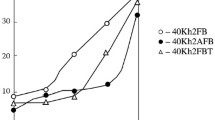Abstract
Cold-rolled steels used for the forged components of automobiles should exhibit high, partly mutually-exclusive properties: high forgeability with desirably high strength, resistance to aging combined with hardenability at temperatures for drying paint coatings, etc. Satisfaction of these requirements is provided to a considerable degree by microalloying. The final mechanical properties of cold-rolled steel depend on such structural parameters of hot-rolled strip as texture, the amount of dissolved C and N atoms in α-solid solution, and ferrite grain size. With constant hot rolling production schedules these structural parameters are governed by steel composition, in particular by the type of microalloying. In this work the effect is considered for dispersed microalloying elements, i.e., phosphorus, boron, titanium, and nïobium, on the final mechanical properties of low- and ultralow-carbon steels.
Similar content being viewed by others
References
E. Spektor and M. M. Borodkina, X-Ray Analysis of the Texture of Metals and Alloys [in Russian], Metallurgiya, Moscow (1981).
A. Werner, Archiv Eisenhüttenwesen,27, No. 7, 449–455 (1956).
K. Tsunoyama et al., “Development of extra-deep drawing cold rolled sheet steels for integrated automotive parts,” Kawasaki Steel Giho,22(3), 177–182.
H. Takeshi, Development and production of IF-steel, (Round Table Discussion of the Metallurgy of Modern IF (Grades), Sponsored by NPC, Düsseldorf, Germany (1990).
T. Senuma et al., “Influence of chemical compositions on the texture formation of low-carbon sheets rolled in α-region,” Tetsu to Hagane, No. 73, 1421 (1987).
S. Sato et al., “Effect of allying elements and hot rolling conditions on the mechanical properties of continuousannealed extra-low-carbon steel sheet,” in: Proc. Symp. Technology of Continuously Annealed Cold-Roiled Steel Sheet, TSM-AIMS (Warrendale; Pennsylvania) (1985), pp. 151–156.
S. Sato et al., “A new process for manufacturing deep drawing cold-rolled steel sheets from extra-low-carbon steels,” Kawasaki Steel Tech. Report, No. 12, 36–44 (1985).
D. B. Titorov, O. A. Girina, and N. M. Fonshtein, “Study of the texture of cold-rolled phosphorus-containing steels of high stampability,” Metally, No. 6, 96–100 (1991).
F. Hessner, Recrystallization of Metallic Materials [Russian translation], Metallurgiya, Moscow (1982).
Additional information
I. P. Bardin Central Scientific Research Institute of Ferrous Metallurgy. Translated from Metallovedenie i Termicheskaya Obrabotka Metallov, No. 3, pp. 21–28, March, 1994.
Rights and permissions
About this article
Cite this article
Girina, O.A., Fonshtein, N.M. & Storozheva, L.M. Effect of microalloying elements on the structure and properties of low-carbon and ultralow-carbon cold-rolled steels. Met Sci Heat Treat 36, 153–162 (1994). https://doi.org/10.1007/BF01398847
Issue Date:
DOI: https://doi.org/10.1007/BF01398847




